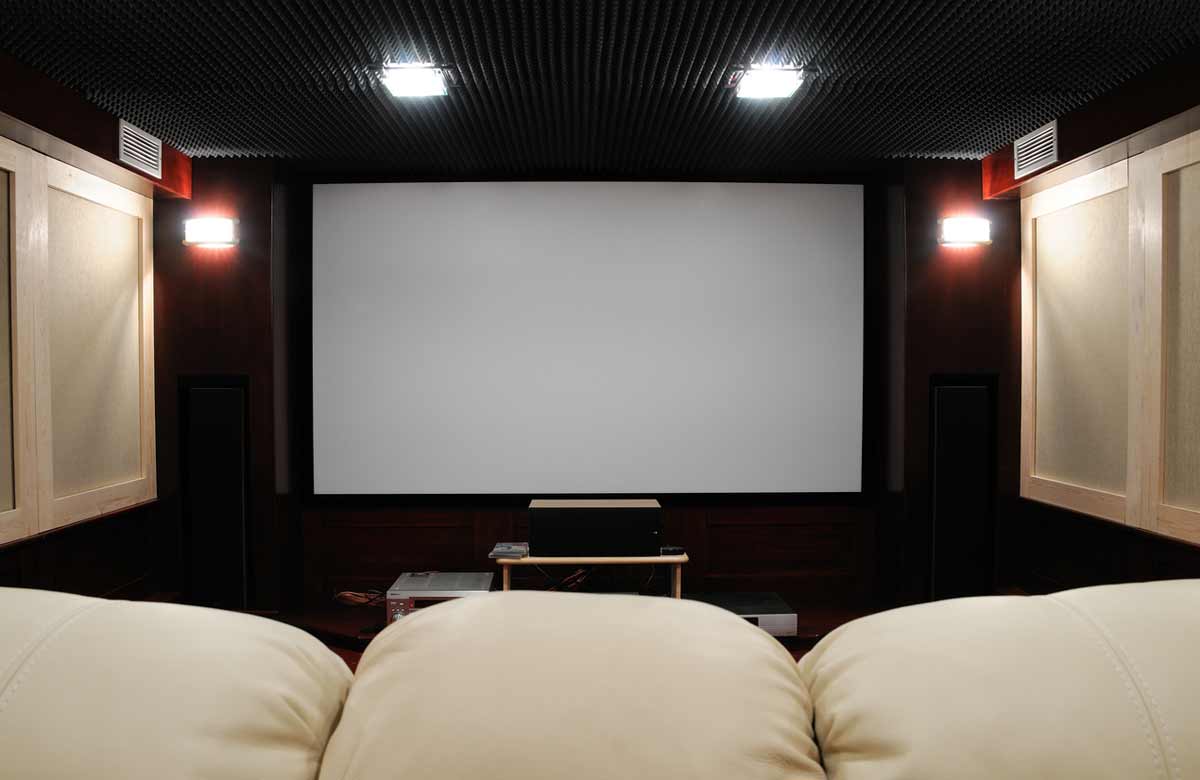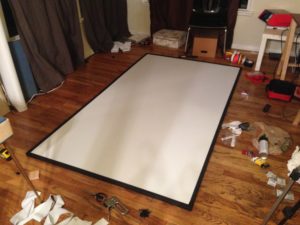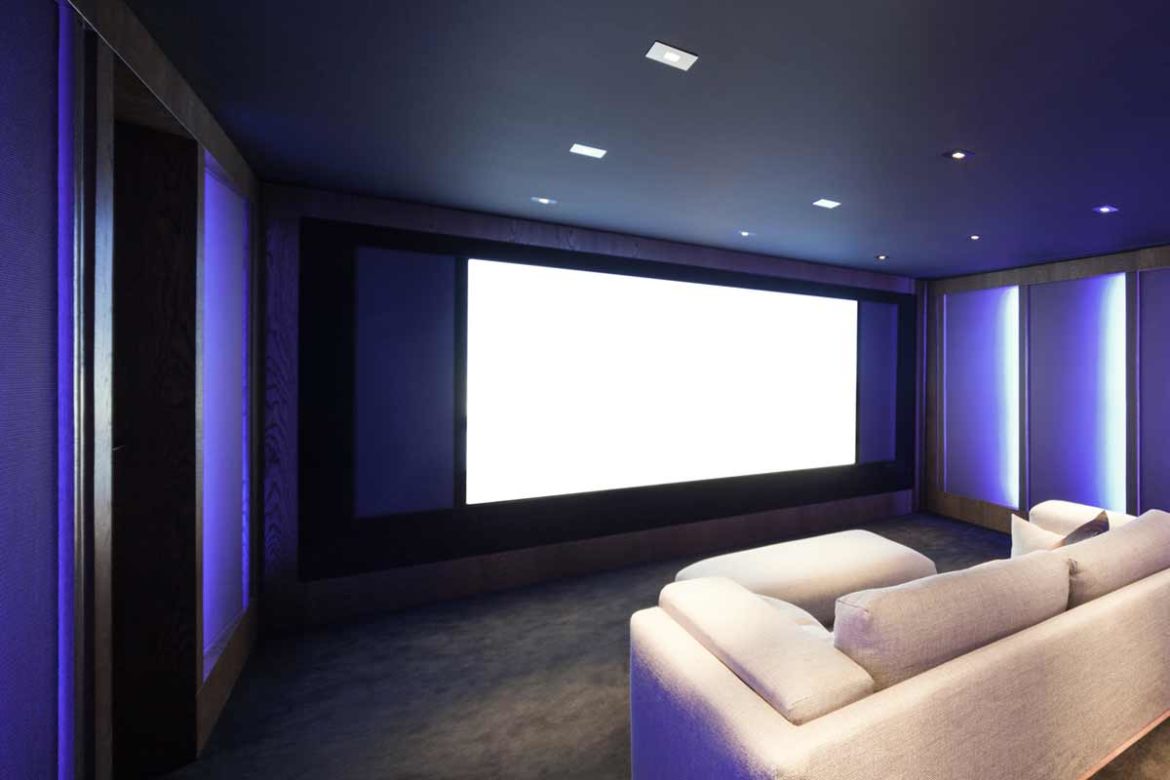Home improvement projects can be a little overwhelming, especially if you’re not too confident in your DIY skills. If you’re curious about making your own home projector screen, though, there are a lot of different ways to approach it.
Whether you’re skilled with a screwdriver or a little intimidated by a paintbrush, we found a project that’s a good fit for your skills. Here are five different ways to make your own projector screen at home. They use a variety of methods including a pretty involved, hands-on project that requires a saw and a drill to one that’s as simple as applying a little bit of paint. Let’s take a closer look at the best ways to create a big screen at home on a budget.
1. Simple Cardboard Projector Screen
OK, so it may not have a remote control, hologram imagery, and touch screen, but this is one of the easiest ways to make a projection screen at home. All you need is
- a large cardboard box (the larger the better)
- spray paint (white is best)
- and hanging strips
The larger the cardboard box, the better (it will create a larger screen size). If you’re lucky enough to have recently had a large piece of furniture delivered, you might have a big box sitting around. If not, large boxes are usually available at home improvement stores.
If you have a box that’s large enough, you can just cut off the top, bottom, and sides, leaving a large square or rectangular shape of flat cardboard. For smaller boxes, you may need to open them flat to get a surface that’s large enough.
Spray paint the viewing surface black, gray, or white and allow it to dry before attaching it to the wall with hanging strips. This is a simple and easy project; unfortunately, it’s a short-term solution. If you take it down and rehang it frequently, it will wear quickly and need replacing.
2. Wrapping Paper
All you need for this next DIY projector screen are scissors, double-sided tape, tape, and a roll of plain white wrapping paper. The wider the wrapping paper, the better. This project can be easily done with one person but having someone to help you will make it go faster and more smoothly.
First, figure out where you want to install your screen. Large, open areas of wall space work best. Start by cutting a piece of wrapping paper, the longer, the better. One word of caution, don’t make it so big that you aren’t able to handle it easily because you want to avoid wrinkles, creases, or tears.
Tape the cut edge of the paper to the top of the screen area and roll it down the wall, securing it in place as you go. Use double-sided tape around the edges. Add another piece right next to it, overlapping the edges slightly. Use tape to hold the inside edge to the adjacent piece of wallpaper.
Continue adding more pieces until you’ve reached the desired size. The most important things to remember about this method are to tape seams carefully and avoid folds and wrinkles in the paper as they’ll affect the image. This is a short-term fix but it definitely gets the job done!
3. Roller Shades
This is a simple way to make a projection screen with the correct aspect ratio that’s more permanent.
You need
- white roller shade (here’s the perfect one for under $70)
- installation hardware
- and an electric drill
Installation is really easy, just mount the shade to a large, empty wall instead of putting it over the window. The best thing about this method is you don’t have to reinstall it every time you want to watch a movie. Just pull the shade down when you need it and put it back up when it’s not in use … all you need then is ambient light and you’re off!

4. DIY Wood Frame Mountable Screen
If you have some DIY skills, making your own framed mountable screen is pretty easy. Here’s what you need
- pine boards
- an electric drill
- screws
- L-brackets
- blackout fabric
- a stapler, scissors, and a measuring tape
First, decide where you’re going to hang the screen. An easy way to make sure you make your screen the right size is to actually use your projector to cast a movie or image onto the wall. Then, measure around the perimeter of the projected image to get the exact dimensions.

Build a frame that’s an inch or two larger than this measurement using the pine boards, making sure to a few boards across the center to support the screen. If you have access to power tools, you can cut the boards to size yourself. If not, take the measurements to any home improvement store and they’ll cut the boards for you. 1”x2” boards are a great size to use because they’re sturdy but not too heavy.
Once you have the boards cut, lay them out and screw them together. Once the frame is completed, it’s time to staple the fabric. The easiest way to do this is to lay the fabric on a large, flat clean surface and place the frame on top of it. Then, start stapling in the center, moving out to the edges. Make sure to keep the fabric taught to avoid bulges and wrinkles.
Once the frame is covered in fabric, you’re done! Attach L-brackets to studs to hang it in place and you’re ready to go!
5. Simple Painted Theater Projector Wall
This is probably the most convenient way to make a DIY projector screen at home because, once you’re done, you never have to worry about installation or setup ever again.
If you have flat, untextured walls in your home and you’re willing to paint them, this is the easiest way to make a big screen at home to go with your portable projector.
All you have to do is paint a large, empty wall with flat white paint.
If you decide that you don’t want to cover the whole wall, use painter’s tape, and a level to block off a section that’s the size you want. Just remember, you’ll be able to see the matte screen is it’s painted against another color or even the same shade of white if it has a semi-gloss or gloss finish. That’s it! You can make the screen as large as you want and it’s always ready for movie night.

